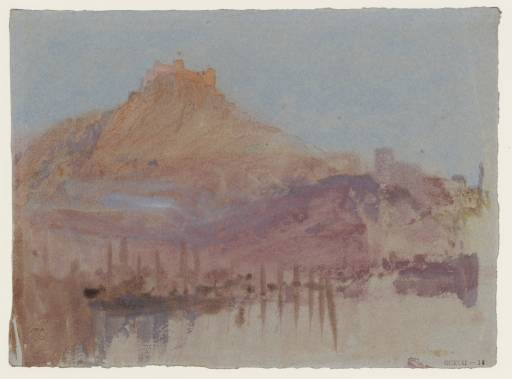Joseph Mallord William Turner Ehrenbreitstein and the Bridge of Boats over the River Rhine 1840
Joseph Mallord William Turner,
Ehrenbreitstein and the Bridge of Boats over the River Rhine
1840
Joseph Mallord William Turner 1775–1851
Ehrenbreitstein and the Bridge of Boats over the River Rhine 1840
D28957
Turner Bequest CCXCII 10
Turner Bequest CCXCII 10
Watercolour and gouache on grey wove paper, 139 x 190 mm
Blind-stamped with Turner Bequest monogram towards bottom left
Stamped in black ‘CCXCII – 10’ bottom right
Blind-stamped with Turner Bequest monogram towards bottom left
Stamped in black ‘CCXCII – 10’ bottom right
Accepted by the nation as part of the Turner Bequest 1856
Exhibition history
1904
National Gallery, London, various dates to at least 1904 (752, as ‘Sketch in France (colour on grey)’).
1995
Turner in Germany, Tate Gallery, London, May–September 1995, Städtische Kunsthalle Mannheim, September 1995–January 1996, Hamburger Kunsthalle, Hamburg, January–March 1996 (81, as ‘Ehrenbreitstein and the Bridge of Boats over the Rhine’, 1840, reproduced; exhibited in Germany only).
2004
Turner and Williamson / In the Haze: Watercolours by Turner and Williamson, Tate Britain, London, January–May 2004, Lady Lever Art Gallery, Port Sunlight, June–August 2004 (no catalogue; exhibited in London only).
References
1904
E.T. Cook and Alexander Wedderburn eds., Library Edition: The Works of John Ruskin: Volume XIII: Turner: The Harbours of England; Catalogues and Notes, London 1904, p.640 no.752, as ‘Sketch in France (colour on grey)’.
1834
A.J. Finberg, A Complete Inventory of the Drawings of the Turner Bequest, London 1909, vol.II, p.938, CCXCII 10, as ‘Castle on mountain. Exhibited Drawings, No.752, N.G.’, c.1834.
1995
Cecilia Powell, Turner in Germany, exhibition catalogue, Tate Gallery, London 1995, pp.145 under no.67, 150 under no.74, 154–5 no.81, as ‘Ehrenbreitstein and the Bridge of Boats over the Rhine’, 1840, reproduced.
Turner addressed Ehrenbreitstein, the imposing fortress complex overlooking the River Rhine opposite its confluence with the Mosel at Coblenz (Koblenz), on many occasions, ranging between slight pencil sketches, colour studies, finished watercolours and an oil painting, as noted below. The lack of detail in the present atmospheric example led to its being called ‘Sketch in France’1 and ‘Castle on mountain’2 in early catalogues, and it was not until 1995 that Cecilia Powell published its true subject, as the ‘last rays of sun catch its high walls while the lower parts of the east bank of the Rhine are already in shadow ... and the masts of the bridge of boats are reflected in the still waters of the foreground.’3
Sketchbooks from other tours include numerous pencil studies: 1817: Waterloo and Rhine and Rhine (Tate; Turner Bequest CLX, CLXI); 1824: Rivers Meuse and Moselle and Trèves and Rhine (CCXVI, CCXVIII; the latter also in watercolour); 1833: Brussels up to Manheim – Rhine (CCXCVI); 1835: Prague, Nuremberg, Frankfurt and Rhine (CCCIV); 1839: First Mossel and Oxford, Trèves to Cochem and Coblenz to Mayence and Cochem to Coblenz – Home (CCLXXXIX, CCXC, CCXCI); 1841: Bern, Heidelberg and Rhine (CCCXXVI); and Rotterdam and Rhine, perhaps from the 1840s (CCCXXII).
There are also various pencil drawings on separate Turner Bequest sheets, and colour studies on blue paper associated with the 1839 tour (Tate D20261, D24804, D24809, D24833; Turner Bequest CCXXII B, CCLIX 239, 244, 268; and National Gallery of Scotland, Edinburgh4). A series of more atmospheric colour studies on white paper followed in 1841 (D35863, D36138, D36166, D36177, D36186, D36206, D40181; CCCLXIV 26, 285, 309, 319, 328, 346, and 328a; and private collection5).
There are two finished watercolours of 1817 (Fogg Art Museum, Cambridge, Massachusetts;6 currently untraced7), 1819–20 (Bury Art Gallery),8 engraved in 1824 (Tate impression: T06067) and 1828 (T06135–T06136, T06630), and about 1832 (also at Bury),9 engraved in 1833 (T04623–T04624, T06148). Another watercolour, possibly of 1840, is untraced.10 In terms of finished treatments the theme culminated in a vignette watercolour (National Gallery of Scotland)11 illustrating Thomas Campbell’s poem ‘Ode to the Germans’, engraved in 1837 (Tate T04784), and the major oil painting The Bright-Stone of Honour (Ehrenbreitstein) and Tomb of Marceau, from Byron's ‘Childe Harold’, exhibited in 1835 (private collection)12 and engraved in 1845, and again in 1859 (T06343).
For the full range of Rhine subjects associated with the present tour, see the Introduction to this subsection.
For the full range of Rhine subjects associated with the present tour, see the Introduction to this subsection.
Technical notes:
There is no pencil work. The thick orange gouache used for the castle and hillside contrasts with the cooler mauve shadows. Horizontal strokes of pale blue gouache towards the left perhaps evoke rising mist. Cecilia Powell has compared the strong colours with those in a contemporary study of Klotten, one of the subjects explored up the nearby River Mosel (Tate D28967; Turner Bequest CCXCII 20).1
Powell has noted this as one of the many sheets of grey 1829 Bally, Ellen and Steart paper used on Turner’s 1840 tour, neatly torn as eighths or sixteenths of the overall sheet, with dimensions of around 190 x 280 or 140 x 190 mm, and variously worked with pencil, watercolour and gouache; see the technical notes in the overall Introduction for others.2
Verso:
Blank; inscribed in pencil ’98 | a’ right of centre; stamped in black with Turner Bequest monogram over ‘CCXCII – 10’ towards bottom left.
Matthew Imms
September 2018
How to cite
Matthew Imms, ‘Ehrenbreitstein and the Bridge of Boats over the River Rhine 1840 by Joseph Mallord William Turner’, catalogue entry, September 2018, in David Blayney Brown (ed.), J.M.W. Turner: Sketchbooks, Drawings and Watercolours, Tate Research Publication, December 2019, https://www

